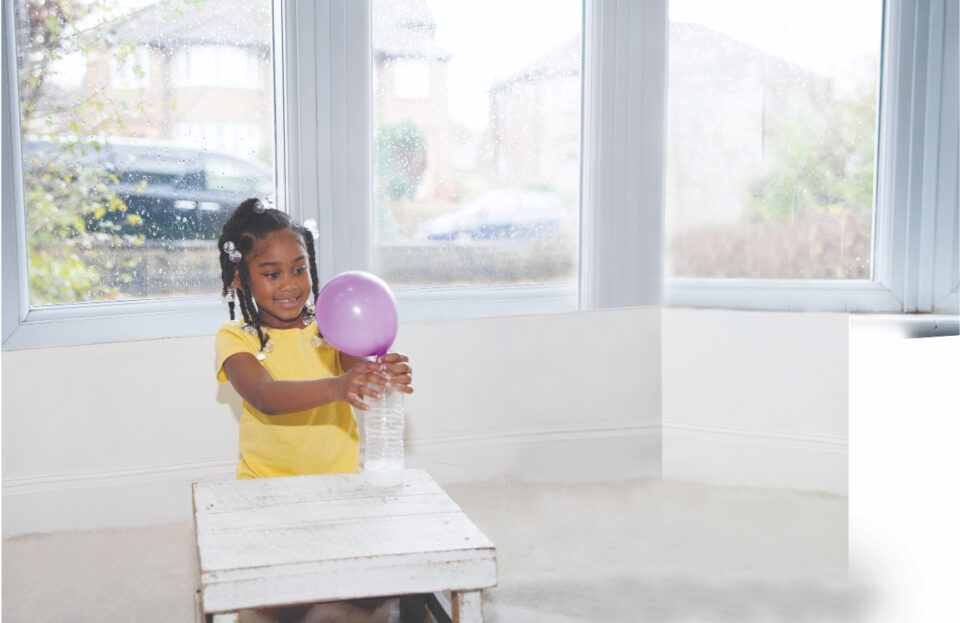We all know the saying “April showers bring May flowers” to be true; however, weathering those April showers with kiddos stuck inside isn’t always sunshine and rainbows. They’re bored (even tired of their screens, too) and they’re rambunctious at times, leaving you with your own little thunderstorms inside. Next time the storms come rumbling in, try some of these kid-friendly science experiments to keep little hands busy and their minds off the weather outside.
Butter in a Jar
To make butter, all you need to do is agitate cream. Sounds easy enough, right? Well, it is, and you can show your children how to make their own right at home. All you will need is heavy cream and a mason jar with a lid. Fill the mason jar with the heavy cream and tightly close the lid of the jar. Then, take turns shaking the jar. Eventually, a butter ball will begin to form. Why? Because when cream is agitated (shaken), the fat molecules get shaken out and clump together. When the butter ball stops growing, you’re done! Take the butter out of the jar (the liquid left over is buttermilk) and it is ready to eat.
Cloud Dough
With 2 cups of flour, ¼ cup vegetable oil, and oil-based food coloring, you and your kiddos can create your own “clouds.” For this experiment, make sure you measure out your materials in order for everything to combine properly. First, mix together your food coloring and vegetable oil. Next, pour in your flour and mix until fully combined. Once combined, your dough will be ready for playtime!
DIY Bouncy Ball
Explore elasticity and bouncing by making your own bouncy balls at home. This experiment requires help from an adult as it contains borax. Be sure to follow the safety guidelines and directions when using borax. Here’s what you will need: ½ cup of water, 1 Tbsp of Borax, and 1-2 tsp of Clear Elmer’s Glue.
First, an adult should create a borax solution combining the borax and warm water. Make sure the borax is completely dissolved before moving to step two. Let it cool before adding your glue into the mixture. The more glue you add, the bigger the ball will be. You can add colorful glitter glue to add some pizzazz to your bouncy ball. Experiment curated by Life’s Carousel.
Floating Shapes
Discuss how density works with your kiddos using only a dry erase marker, water, and a glass plate. Using the dry erase marker of your choice, draw shapes onto your glass plate. Next, slowly pour water over the shapes and watch as your drawings lift from the plate and float around. The magic of this experiment lies within the dry erase marker’s insoluble ink.
Fireworks in a Jar
While rain isn’t the most ideal weather for fireworks, these can be “popped” on any day! This science experiment explores what happens when oil meets water. All you will need is warm water, liquid food coloring, vegetable oil, and two glass jars.
Fill one jar with warm water. In your second jar, add your vegetable oil and food coloring and stir to combine. Then, carefully pour the colorful vegetable oil into the jar with the warm water for a firework display indoors.
Ice Cream in a Bag
Remember making your own ice cream in science class? Why not make your own at home? All you will need is one cup half and half, 2 Tbsp sugar, ½ tsp vanilla extract, ice, ⅓ cup rock salt, a sandwich bag, and a gallon bag.
In a container, mix together the half and half, sugar, and vanilla extract. Pour the mixture into the sandwich bag and seal. In your gallon bag, fill the bag with ice and the rock salt. Place the sandwich bag inside the gallon bag and seal the gallon bag. Finally, take turns shaking the bag until your sweet treat is ready to eat. You’ll know it’s ready when the liquid changes consistency to ice cream; it’s a perfect lesson on matter.
Self-Inflating Balloon
You’ll see a balloon inflate right before your eyes with this experiment that creates a gas-producing chemical reaction. You will need an empty plastic bottle, a balloon, 3 tsp baking soda, and ⅓ cup vinegar.
First, pour the vinegar into the plastic bottle and set aside. Next, have one person hold open the balloon while the other pours in the baking soda. Make sure the baking soda is as far in the balloon as you can get it. Then, stretch the neck of the balloon over the mouth of the bottle, careful to not let any of the baking soda get inside the bottle. Finally, have your kiddo shake the bottle until the baking soda empties from the balloon into the bottle. This experiment causes carbon dioxide gas to create, and since it doesn’t have anywhere to go, it pushes through the bottle and inflates the balloon.
Walking Water
A lesson in absorption and mixing colors is easy and a lot of fun with this water-ful experiment. For this experiment, you will need six small glass jars, paper towels, food coloring, and water.
We recommend setting up your experiment on a tray so it’s easy to transport and easy to clean up.
First, take three jars and fill them with water. Next, add drops of food coloring into each jar and stir to combine. You can choose one color or a variety of colors for a cooler look. Pattern your three colorful jars with your three empty jars in a circle (colorful jar, empty jar, colorful jar, etc.). Then, take your paper towels and fold them into strips. You will need six strips total. Place one end of each paper towel strip into a colorful jar and one in an empty jar. From there, you and kiddos can watch the water “walk” up the paper towel strip and move into the empty jar. Soon enough, there will be colorful water in all of the jars.





